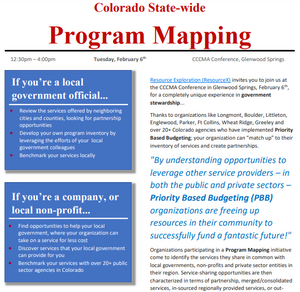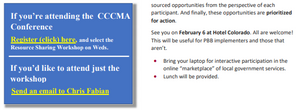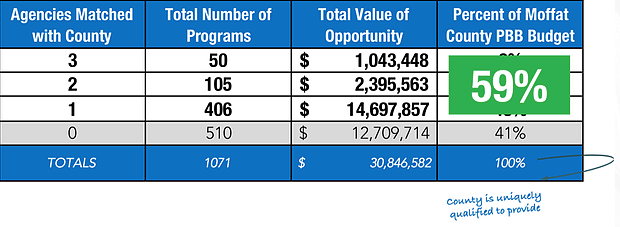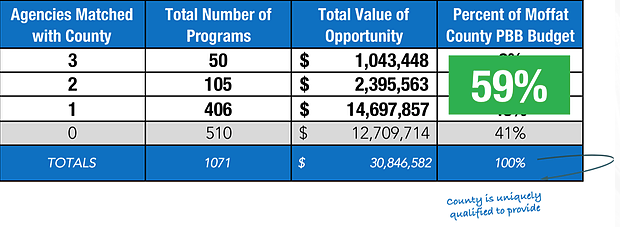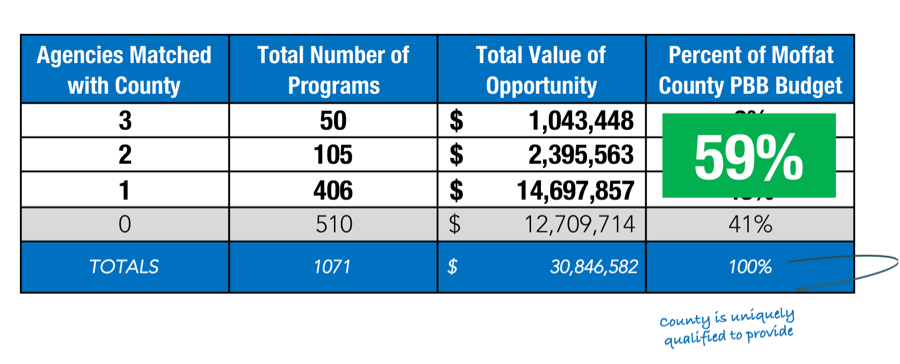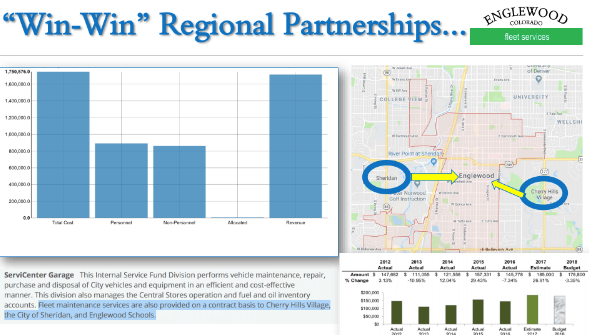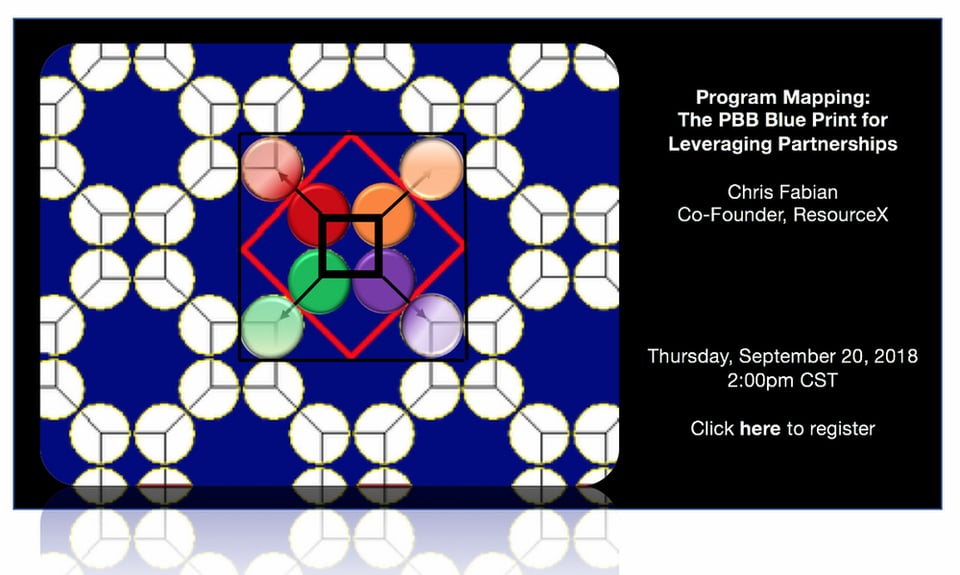"This state-wide and regional approach to understanding program commonality across a community (city, school district, hospitals, county, non-profit organizations and other private sector entities) is unleashing powerful and abundant partnership opportunities in an incredibly original way."
"By understanding opportunities to leverage other service providers – in both the public and private sectors – PBB organizations are freeing up resources in their community to successfully fund a fantastic future!"
The Colorado City & County Management Association (CCCMA), with Resource Exploration (formerly the Center for Priority Based Budgeting) invites you to join us for a completely unique experience in government stewardship...
PROGRAM MAPPING
February 6, 2019 | 12:30pm - 4pm | CCCMA Annual Conference (Glenwood Springs, CO)
(*See full agenda + presentation details at the end of this article)
Resource X is offering a completely unique experience in government stewardship. Matching up programs and creating partnerships! The goal of the Colorado State-wide Initiative is to facilitate the identification of every program offered by every local government across the State, the costs of providing every program, and the opportunity to optimize and prioritize resources across all communities.
Since there is already a "critical mass/density" in Colorado, in terms of having 26 PBB implementers (“catalyst communities”), Program Mapping initiatives will be launched through each of the regions and bring every non-PBB local government quickly up to speed in terms of matching up their services.
Thanks to organizations like Longmont, Boulder, Littleton, Englewood, Parker, Ft Collins, Wheat Ridge, Greeley and over 20+ Colorado agencies who have implemented Priority Based Budgeting, your organization can “match up” to their inventory of services and create efficient and collaborative partnerships!
We are proud to call so many Colorado communities our partners! And this event provides the perfect platform for Program Mapping! The incredible VALUE is this..... Neighboring service providers from the public sector (neighboring cities, towns, county gov, school district, etc), non-profit, healthcare, and private sector (usually represented by a local Chamber of Commerce) participate in Program Mapping Workshop(s) to "match up" the services they offer, to the services identified by the "PBB catalyst community!"
PBB catalyst communities are those who have already implemented priority based budgeting and are actively applying PBB data (in part through program mapping). See a map of Colorado PBB catalyst communities below.
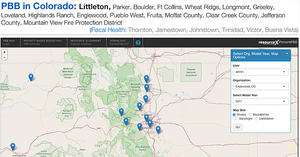
A Fantastic Future
In order to refuel our unique and extraordinary efforts as local governments to dramatically improve the future, we must mine from within. But how?
The concept is quite simple, and yet can sometimes escape us: how can we discover and partner with other organizations in our community who are pursuing the same societal objectives as we are? Can we leverage their efforts, programs and services to tackle the challenges we seek to address in our community? And can we discover opportunities to not only partner but merge and consolidate services, thereby freeing up our own staff and money to reallocate elsewhere?
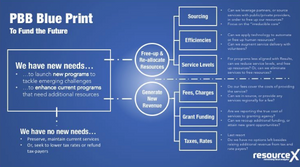
How It Works
When a local government like City of Littleton implements PBB they become a “catalyst” for the identification of partnerships in their community.
Littleton is a PBB catalyst community - this means they have identified each and every service they provide ("snow removal," "animal control," "police patrol", "street sweeping" etc), the costs and workforce dedicated to each service, the measurable influence (or lack thereof) of each service on societal goals (safer cities, local economic vitality, environmental sustainability, etc), and other key attributes for every service (is the service provided by another entity, is it mandated, does it recover costs through grants or fees, etc).
Neighboring service providers from the public sector (neighboring cities, towns, county gov, school district, etc), non-profit, healthcare, and private sector (usually represented by a local Chamber of Commerce) participate in Program Mapping Workshop(s) to "match up" the services they offer, to the services identified by the "PBB catalyst community."
This approach is an accelerator and a short-cut, as the "non-PBB" service providers don't have to implement PBB. They benefit from the catalyst community having gone through the work. And by "matching up" services to the catalyst community, a universe of potential program partnerships opens up to provide a fast-track to optimizing resources in a very dramatic way across a region.
Participating organizations come to identify the services they share in common (“match up”) with the local government in their region. Service-sharing opportunities in common are then characterized in terms of partnership, merged/consolidated services, in-sourced regionally provided services, or out-sourced opportunities from the perspective of each participant. And finally, these opportunities are further characterized and prioritized in terms of the magnitude of complexity in implementing a shared-service approach, and the value of the opportunity once realized.
Project Spotlight:
Program Mapping between Englewood, CO and Littleton, CO
Both the cities of Englewood and Littleton, Colorado are Priority Based Budgeting implementers and neighbors (Catalyst Communities). The ResourceX Program Mapping process was ideal for
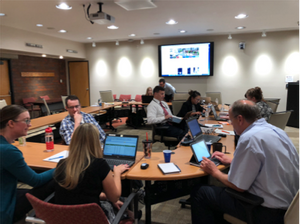
these two forward-thinking communities to undertake, using the data they’d each produced, to identify the services you share in common (“match up”) with each other.
Leadership from both cities came together for a ½-day interactive workshop, engaging in the Program Mapping online software platform to scour the service catalogues from their neighbor.
Entrepreneurially, the participants sought and discovered opportunities to in-source programs entirely to provide to the other city, as a more efficient model of service delivery where one of the cities was positioned better to provide the service regionally. This would be a revenue generating opportunity to the in-sourcing city, and ideally an efficiency (resourcing the service, for less) to both entities given the economy of scale that could be produced.
Opportunistically, the participants sought and discovered opportunities that took the form of advantageous out-sourcing – where one could imagine getting services off of their plate,
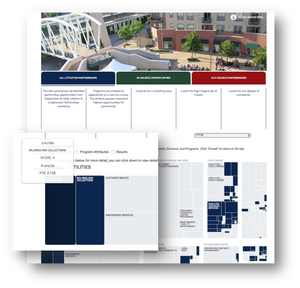
reducing the need for their own city to provide a service if it could be provided by their neighbor. And in turn, allowing their city to “free up and reallocate” their own resources towards the high priority pursuits (new programs they need to launch, or current services that need enhancement) that they may not be able to fund today.
Finally, beyond partnerships or mergers, the cities simply learned immensely from each other. In certain cases, one organization was charging a fee for a service that the other organization is entirely subsidizing with general government resources. In other cases, one of the organizations provided a service that the other organization currently privatizes or doesn’t provide at all.
*Above Image: Online Program Mapping Platform for the City of Englewood, highlighting the program of “Utility Billing.” Littleton city manager Mark Relph observed: “there’s no unique community character, no ‘Littleton’ or ‘Englewood’ brand in how we provide ‘utility billing’ – this partnership just makes sense.”
From a benchmarking perspective, the cities can begin to compare the costs of providing services, FTE (workload) support, and BPA and Result scores.
From a policy intelligence perspective, the cities can begin to learn from each other interesting policy insights surrounding cost recovery of specific programs, sourcing, and overall community priority.
The communities are currently working together on the logistical and intergovernmental agreement details to make collaboration a reality.
ResourceX provides the following live web-links to analyze the ongoing municipal collaboration opportunities between the two cities:
https://openpbbdata.net/Littleton/
https://openpbbdata.net/Englewood/
Consider These Outcomes
In Moffat County, they have discovered that 59% of the County’s entire budget is invested in programs that other local service providers also are providing. These could be services that the County decides to provide in partnership with the local provider, outsource to the local provider to free up resources, or in-source to the County in exchange for revenue.
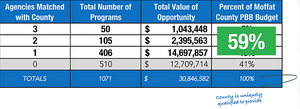
In addition, Moffat County has learned that the remaining 41% of their budget is invested in programs that the County is currently uniquely qualified to provide (a much lower percentage than was anticipated, which is a good finding given the scarcity of resources to ensure are prioritized).
In Clear Creek County, the incredible discovery made was that the County has upwards of 78% of it’s budget invested in programs for which they could leverage local partners, outsource to, or in-source from to either free up resources for reallocation, or generate new revenue. Amazingly this leaves 22% of the County’s budget allocated to programs for which there are no apparent partners to consider, at least given the scope of the partnership exploration thus far conducted.
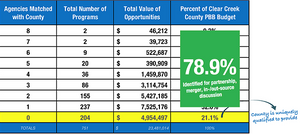
Through Program Mapping, Priority Based Budgeting communities are showing us the way to an entirely different future. By rethinking the services we offer, reassessing (re-understanding) and clarifying why we’re relevant to the public, and substantially reallocating the abundance of resources available to government and to every institution serving the public good, these communities have created a profoundly compelling alternative solution to freeing up vast amounts of resources.
And by understanding their opportunities to leverage other service providers – in both the public and private sectors – they are freeing up resources in their community to successfully approach the future.
Program Mapping Agenda & Program
Workshop Agenda, Wednesday February 6, 2019 | Hotel Colorado (Glenwood Springs, CO):
12:30 p.m. – Registration of workshop guests / Networking in room over continental breakfast
1:00 p.m. – Intro to “Program Mapping” and Colorado’s “Catalyst Communities”
1:30 p.m. – Hands-on Mapping Exercise – Maximizing Opportunity List
2:15 p.m. – Services Sharing Opportunities – Classification, Differentiation and Prioritization
3:00 p.m. – Shared Services Opportunity Savings Calculation
4:00 p.m. – End of Event
20 min: Introduction to Program Mapping
Organizations participating in a Program Mapping initiative come to identify the services they share in common (“match up”) with local governments, non-profits and private sector entities in their region. Service-sharing opportunities in common are then to be characterized in terms of partnership, merged/consolidated services, in-sourced regionally provided services, or out-sourced opportunities from the perspective of each participant. And finally, these opportunities are further characterized and prioritized in terms of the magnitude of complexity in implementing a shared-service approach, and the value of the opportunity if it were to be realized.
10 min: Explanation of “catalyst communities”
When a local government like Littleton implements PBB they become a “catalyst” for the identification of partnerships in their community. Longmont is a PBB catalyst community - this means they have identified each and every service they provide ("snow removal," "animal control," "police patrol", "street sweeping" etc.), the costs and workforce dedicated to each service, the measurable influence (or lack thereof) of each service on societal goals (safer cities, local economic vitality, environmental sustainability, etc.), and other key attributes for every service (is the service provided by another entity, is it mandated, does it recover costs through grants or fees, etc.).
45 min: Hands-on participation in online “Program Map” to match-up services
Neighboring service providers from the public sector (neighboring cities, towns, school district, etc.), non-profit, healthcare, and private sector (usually represented by a local Chamber of Commerce) are invited to "match up" the services they offer, to the services identified by the "PBB catalyst community." This approach is an accelerator and a short-cut, as the "non-PBB" service providers don't have to implement PBB. They benefit from the catalyst community having gone through the work. And by "matching up" services to the catalyst community, a universe of potential program partnerships opens up to provide a fast-track to optimizing resources in a very dramatic way across a region.
45 min: Opportunity Classification, Differentiation and Prioritization
Entrepreneurially, Program Mappers seek opportunities to in-source programs entirely to provide to other entities, as a more efficient model of service delivery where they’re positioned better to provide the service regionally. This would be a revenue generating opportunity to the in-sourcing entity, and ideally an efficiency (resourcing the service, for less) to both entities given the economy of scale that could be produced.
Opportunistically, Mappers seek opportunities that take the form of advantageous out-sourcing – where organizations can imagine getting services off of their plate, reducing the need for their own organization to provide a service if it could be provided by another local entity. And in turn, allowing their organization to “free up and reallocate” their own resources towards the high priority pursuits (new programs they need to launch, or current services that need enhancement) that they may not be able to fund today.
Finally, beyond partnerships or mergers, Mappers stand the chance to simply learn immensely from each other. Maybe one of your organizations is charging a fee for a service that the other organization is entirely subsidizing with general government resources. Perhaps one of your organizations provides a service that the other organization currently privatizes, or doesn’t provide at all.
From a benchmarking perspective, you can begin to compare the costs of providing services, FTE (workload) support, and BPA and Result scores
From a policy intelligence perspective, you can begin to learn from each other interesting policy insights surrounding cost recovery of specific programs, sourcing, and overall community priority.
Register TODAY!
Contact us with any additional questions.
